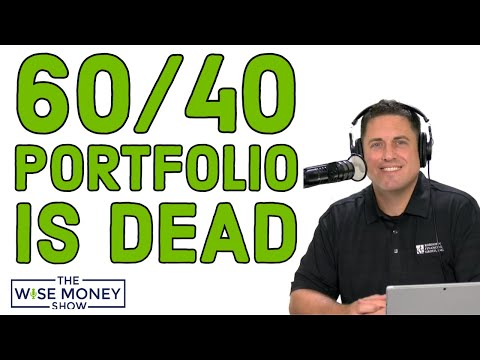- Simple and easy to implement, a 60/40 portfolio allocation has worked well in the past 40 years.
- This investing rule might not work in the coming years as bond yields are very low.
- Investors should diversify into other assets, such as gold.
You’ve probably heard of the 60/40 portfolio allocation as many investment advisers use this investing rule. It consists of allocating 60% of a portfolio to equities and 40% to bonds.
The idea is that this allocation will capture the long-term gains made by stocks while relying on safe fixed-income assets (like government bonds) during short-term stock market downturns.
This Investing Strategy Has Worked Well In The Past
Bonds hedge growth risk, and stocks hedge against inflation. The 60/40 investing rule currently works because the results are negatively correlated. But that correlation could switch soon, which is one reason the allocation might no longer work.
A 60/40 portfolio is no longer enough for investors. Watch the video below:
The traditional allocation has performed admirably over the past four to five decades, yielding around 10% per year over that period.
A 60/40 fund would have also helped offset losses this year. Vanguard’s Balanced Index Fund posted a gain of more than 4% since the start of the year. The S&P 500 is down more than 1% over the same period.
While this portfolio has worked reasonably well over the past 40 years, the strategy could be running out of steam.
Bond Yields Are Too Low
Currently, the 10-year U.S. Treasury note yield stands at 0.68%. Bond prices move in the opposite direction of yields.
Low bond yields are becoming problematic for investors looking for growth.
As people are living longer, their retirement will last longer. They need more money to cover higher expenses.
Daniel Hill, president and CEO of Virginia-based Hill Wealth Strategies, said:
The 60/40 portfolio is no longer a good option for investors to place their entire retirement in because people are living longer and should plan for 20 to 30 years of retirement. This has potential to be problematic because as inflation rises, so will expenses when they’re in retirement.
Returns on a 60/40 portfolio may not be enough to keep pace with inflation.
Another problem is that the diversification potential of such a portfolio is limited. During periods of market volatility, both bonds and stocks can fall.
Income from bonds is no longer high enough to support portfolio during market downturns.
Adam Phillips, director of portfolio strategy at EP Wealth Advisors in Torrance, California, said:
In the past, investors were able to rely on income provided by their bond investments to support their portfolios during periods of market stress. Unfortunately, today’s low-yield environment means the diversification benefit from bonds will not be as large as in the past.
JP Morgan says a traditional 60/40 portfolio will offer 3.5% annual returns over the next decade, compared with 10% over the past few decades.
Jan Loeys and Shiny Kundu, strategists at JP Morgan, said in a note:
In the zero-yield world, which we think will be with us for years, bonds offer neither much return nor protection against equity falls.
Unless long-term yields turn negative, the ability of bonds to offset declines in the portfolio’s share of risky assets may be limited. If inflation materializes or the Fed hikes rates, investors holding long-term government bonds could suffer painful losses.
Investors Should Diversify Into Other Asset Classes
Investors’ needs change throughout their life. Relying on general investment rules can put them at a disadvantage when they do not consider specific needs, goals, or life stages. Younger investors might prefer to have a more aggressive investment strategy as they are far from retirement. Some of them are 100% invested in stocks, but that’s a risky strategy.
A well-diversified portfolio should include more asset classes than just stocks and bonds.
Alternative investments such as hedge funds, real estate, commodities, precious metals, private equity, and inflation-protected assets are new additions to the well-balanced portfolio. A portfolio that includes several asset classes can have a higher return with a lower risk than a traditional portfolio. Watch the video:

Adding gold to a portfolio is a good idea. The investment characteristics of gold are very different from traditional assets like stocks and bonds. Gold tends to outperform during times in which stocks and bonds underperform. The world enters a new era of investing, which may not be favorable to the standard 60/40 portfolio.
Disclaimer: This article represents the author’s opinion and should not be considered investment or trading advice from CCN.com. Unless otherwise noted, the author has no position in any of the securities mentioned.
Sam Bourgi edited this article for CCN.com. If you see a breach of our Code of Ethics or find a factual, spelling, or grammar error, please contact us.




